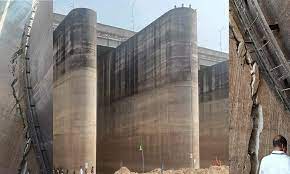- The Kaleshwaram Lift Irrigation Project (KLIP) has come under fire for sinking piers at the Medigadda barrage.
- To address these concerns, the National Dam Safety Authority (NDSA) will conduct a thorough review of the project.
What is Kaleshwaram Project?
| Details | |
| Location | Kaleshwaram Village, Telangana, India.Earlier known as the Pranahita-Chevella Lift Irrigation Project. |
| Confluence Point | Pranhita-Godavari River confluence |
| Project Size | Claimed to be the world’s largest multi-stage and multi-purpose lift irrigation project |
| Key Features | Series of underground and surface water pumping stations, stretching over 300 km |
| Purpose | Supply water to 45 lakh acres in Telangana |
| Commencement | Started in 2016, utilizing approximately 283 TMC of water from the Godavari River |
| Components | Divided into 7 linkages and 28 bundles over 13 districts.Aims to source 240 TMC of water.Construction of a barrage near Medigadda, with water reverse-pumped into the Godavari River |
| Major Pumping Facilities | Ramadugu (largest), Medaram, Annaram, and Sundilla |
About National Dam Safety Authority (NDSA): Ensuring Dam Safety in India
- The NDSA is critical to ensuring that dam safety standards are met nationwide.
- Constitutional Base: Although water management is on the State List, the Union government has the jurisdiction to adopt dam safety legislation under Article 246 of the Constitution. (Parliament has the authority to establish laws for any portion of India that is not included in a state, regardless of whether the subject is on the State List.)
- Dam Safety Act (2021): Parliament established the Dam Safety Act, which establishes an institutional system for guaranteeing dam safety in India.
Objectives and Functions
- Institutional Mechanism: The NDSA is responsible for maintaining dam safety standards, preventing dam-related tragedies, and responding to interstate dam issues.
- The authority is led by a chairman and assisted by five members with competence in a variety of areas, including policy and research, technical elements, regulation, disaster management, resilience, administration, and finance.
- Surveillance and Inspection: Special arrangements have been put in place to monitor, inspect, operate, and maintain all large dams in the country in order to prevent dam failure-related tragedies.
- punitive requirements: To ensure compliance, the Dam Safety Act includes punitive requirements as well as a list of offences and fines.
Organizational Setup
- The NDSA’s headquarters are located in the National Capital Region.
- Regional Offices: The authority is supported by four regional offices strategically located around the country to ensure effective dam safety oversight and administration.
Source: https://www.thehindu.com/news/national/telangana/ndsa-expert-panel-to-examine-kaleshwaram-project-on-march-6-telangana-irrigation-minister/article67910030.ece#:~:text=Further%2C%20the%20panel%20has%20been,to%20interact%20with%20stakeholders%2Fagencies

